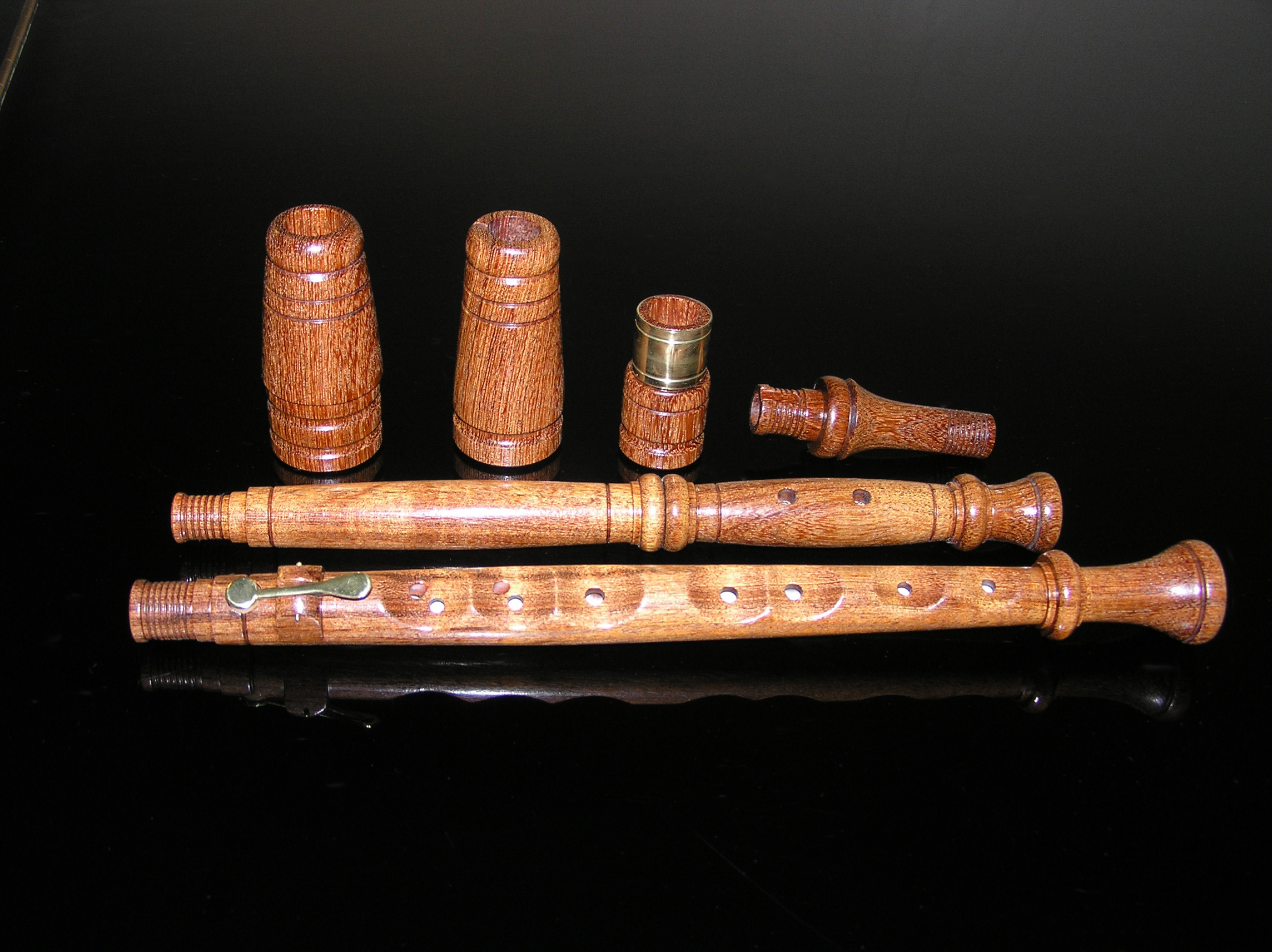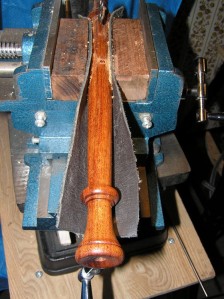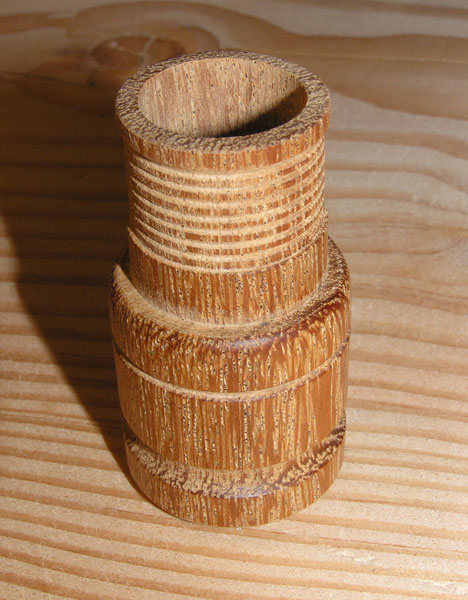By Boris Favre
I was recently commissioned to make a set of Swedish bagpipes out of mesquite. While I favour the classic timbers for making woodwinds – blackwood, boxwood and olive – I’m always interested in trying out new wood species for pipes. My customer wanted  his pipes made from a sustainable, native North American hardwood which is a very worthwhile consideration in this age of diminishing forests and concern over greenhouse emissions. I have tried other local species like hard maple, plum, cherry and holly, all of which are good for making pipes, but now having worked mesquite I wanted to share my impressions with the piping community.
his pipes made from a sustainable, native North American hardwood which is a very worthwhile consideration in this age of diminishing forests and concern over greenhouse emissions. I have tried other local species like hard maple, plum, cherry and holly, all of which are good for making pipes, but now having worked mesquite I wanted to share my impressions with the piping community.
I ordered the mesquite online from the US. I was surprised at how uncommon it was to find mesquite on wood suppliers’ product lists, it being a plentiful domestic species. There were only a handful of retailers who offered it. The wood itself is quite light but hard, beige in colour with distinct grain and small pore lines running along the grain. It reminds me a lot of Honduras rosewood which I have worked with before, and it has similar machining properties.
All of my turning is done freehand using a wood lathe and chisels. I found that mesquite did not turn well at slower speeds and I had to work at much higher rpm’s than blackwood or olive to prevent the grain from tearing, as it is fibrous and somewhat stringy. The chisel has a tendency to catch the tiny pore lines and tear out the wood rather than make a clean cut, at higher speeds, however, this problem was greatly reduced. Because of this quality, I found that using scraping tools did not work so well and I had to exclusively work with sharp chisels that have a beveled cutting edge and a clean cutting action. When it came time to profile the beads and detailed areas it called for a little more care than usual, since any tear-out would result in rough edges which have a high tendency to catch on a second pass of the chisel. I found that my skills as a turner were being tested, and so I  wouldn’t recommend this wood for a beginning pipemaker. Having said that, it all turned out quite clean in the end and mesquite proved to be most suitable for a bagpipe. If it is to be used for wet pipes however, it would definitely need some kind of oil treatment against moisture since it is a porous timber. Mesquite sands very well which can come in handy, especially for sanding the traditional Swedish scallops at the finger holes.
wouldn’t recommend this wood for a beginning pipemaker. Having said that, it all turned out quite clean in the end and mesquite proved to be most suitable for a bagpipe. If it is to be used for wet pipes however, it would definitely need some kind of oil treatment against moisture since it is a porous timber. Mesquite sands very well which can come in handy, especially for sanding the traditional Swedish scallops at the finger holes.
Regarding the boring and drilling of the tone holes, these were a breeze but I did boost the speed a little more than usual. The wood drills quickly and easily so I was able to avoid any burnout. Milling the key channel required extra care because of the fibrous properties of the wood and I felt that it was best to make a single cut rather than take a chance by following up with a second pass of the cutting bit. I was able to remove the excess key block material with a whittling knife which saved me having to sand it down. The wood is susceptible to splintering and, much like a fault line, there is a risk of breaking a chunk off if one is too eager to remove larger chunks at a time. If you are a good whittler, you can do some interesting designs with this wood.
The mesquite looks very plain while it is on the lathe, but after I soaked it in walnut oil and followed it up with a three-step buffing process – tripoli rouge, white diamond and carnauba wax – the grain and colour really came to life. Now a medium-dark brown colour, it is an attractive wood and it looks even more like Honduras Rosewood after the same treatment.
One point worth mentioning about mesquite is that it is extremely fragrant. It gives off a sweet, floral smell as it is being worked and one could almost wear it as a cologne. I can see where it gets its full name “honey mesquite” from and why it is used in BBQ’s to add flavour. I would assume that hickory, another native North American hardwood, would be quite similar.
To conclude, I believe mesquite is as effective as any fruit wood for making a set of bagpipes. My preference is for a denser wood because it repels moisture better, and I like to hold a bit more weight when I play pipes. I’m the same way with piano keyboards where I favour a heavier action, but for those who prefer lighter pipes I would have no problem recommending mesquite, especially for a bellows blown set. As for sound quality, I am of the camp that the wood itself has minimal effect on tone since it is the reed and the air column, and not the  vibration of the wood, that affects tone. Having said that, I do believe that a very dense wood like blackwood does leave a smoother finish in the bore and therefore likely allows a few more harmonic overtones to get through, brightening the tone.
vibration of the wood, that affects tone. Having said that, I do believe that a very dense wood like blackwood does leave a smoother finish in the bore and therefore likely allows a few more harmonic overtones to get through, brightening the tone.
I hope that this brief review of honey mesquite has been helpful, and good luck with your project if you do end up giving it a try.
All the best,
Boris Favre
Boris Favre is a musician and instrument maker originally from Lyon, France now settled in Canada. He is the inventor of the Canadian Bagpipe. You can see more of his work on his website here.

I completely agree about the working properties of Honey Mesquite, that is why I prefer Black Mesquite over Honey Mesquite. I have about 20 acres of the stuff growing on the farm where I grew up and my parents still live. This stuff grows everywhere in Texas and makes a good bagpipe and a good brisket. Seth